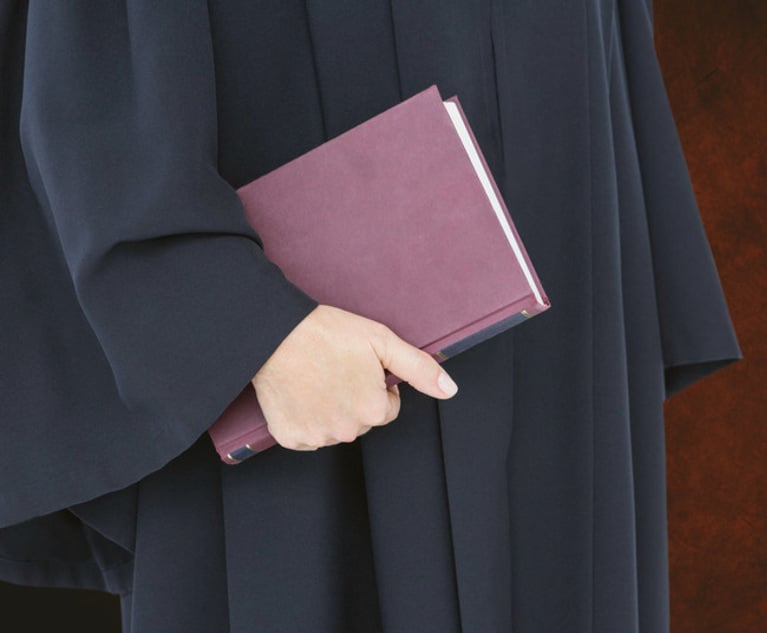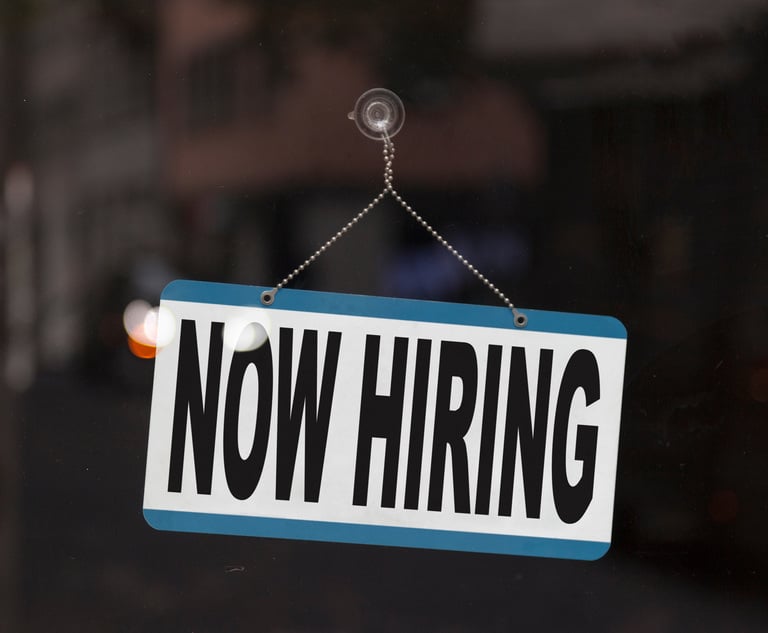 Joel Feldman, Greenberg Traurig, Atlanta
Joel Feldman, Greenberg Traurig, AtlantaThe Big Winners in SCOTUS' Booking.com Decision Have Big Trademark Prosecution Budgets
A clear win for Booking.com and brand owners also creates more uncertainties than it resolves.
July 01, 2020 at 06:28 PM
7 minute read
The Hot Take
For the third time in four years, the Supreme Court ruled that the U.S. Trademark Office, both at the examination and Trademark Trial and Appeal Board (TTAB) levels, had examination guidelines that led to the improper refusal to register an applied-for mark. In United States Patent and Trademark Office v. Booking.com B.V., 591 U.S. ____ (2020), the Trademark Office urged the court to adopt a bright-line rule that the combination of a generic term + .com is always generic and therefore incapable of federal registration. In an 8-1 decision Tuesday, the court declined to establish such a rule, opining that each "generic.com" mark must be evaluated on its merits based on the prevailing consumer perception of the applied-for mark. Consequently, the court did not disturb the lower court's holding that BOOKING.COM is a protectable trademark because BOOKING.COM has a quantifiable source-identifying significance to consumers independent from the word booking.
Aside from Justice Ruth Bader Ginsburg's always-brilliant storytelling, the text of the court's decision is not particularly remarkable. The decision revolves around two basic principles. First, trademark law is intended to reflect and protect consumer perceptions. Second, per se trademark rules are generally incompatible with the goal of reflecting and protecting consumer perceptions. Adding these two principles together, the court delicately dismissed the Trademark Office's arguments regarding the potential anti-competitive dangers of issuing registrations for generic.com trademarks and created a narrow, to-be-defined path for the registration of generic.com marks.
The Deeper Dive
While the court's decision seems like a win for brand owners (especially those with large trademark prosecution budgets), the court's holding creates more uncertainties than it resolves. Put differently, if the court had refused to register booking.com as a matter of law (as Justice Stephen Breyer urged in his powerful dissent), such a refusal would have created a far cleaner and more-predictable landscape than the now-prevailing rule that ever-changing and difficult-to-measure consumer perceptions will, on a case-by-case basis, govern the registrability (and enforceability) of each generic.com mark. The resolution of the questions explored below, and several others, will define the legacy of the court's booking.com decision.
First, how will the Trademark Office determine whether the combination of a generic term and .com (or .net, .org, etc.?) yields "additional meaning to consumers capable of distinguishing the goods or services"? Notably, the court was careful to clarify "we do not embrace a rule automatically classifying such terms as nongeneric." Accordingly, because the eligibility of a generic.com mark for registration will almost always require close and careful evaluation of acquired distinctiveness evidence, a tribunal of TTAB judges, rather than a single examiner, will likely initially set the standards for registration. Because of the potential ramifications of granting a generic.com registration, most trademark practitioners will welcome the scrutiny of three experienced trademark judges in the process. Over time, however, TTAB decisions become examination guidelines for individual trademark examiners. So it remains to be seen if and when trademark examiners will be able to approve generic.com applications on their own.
Second, will the decision, as Breyer fears, lead to the "proliferation of 'generic.com' marks?" Even though the court left open the possibility of registering generic.com marks, there is no question that applicants will face a costly uphill battle to overcome the presumption that the applied-for generic.com mark is not registrable. In addition, the Trademark Office's records are publicly available online, and there is no way to submit evidence of acquired distinctiveness (typically sales and advertising data) under seal. Many companies consider this data commercially sensitive and will hesitate to make this information publicly available, at least until it can quantify the value of generic.com registration vis-a-vis the business risk of the disclosure.
Third, even if an applicant secures a registration for its generic.com mark, will the registration be a paper tiger (appearing powerful and threatening but ineffective under the scrutiny of litigation) that primarily serves vanity purposes? Will it block third parties that apply for composite marks incorporating the generic term as an element (with a disclaimer)? Only time will tell how the Trademark Office, TTAB, and federal district courts will handle the Herculean task of defining the exclusivity afforded the registration of a generic.com mark. The court acknowledged two hypothetical conflicts raised by the Trademark Office—vis-a-vis booking.com, ebooking.com and hotel-booking.com—but failed to offer any insight as to how such conflicts should be resolved. Nevertheless, the threat of trademark litigation is a powerful enforcement tool.
The court suggests that concerns with overaggressive enforcement of generic.com registrations are mitigated by classic fair use principles and long-standing jurisprudence that conceptually weak marks are entitled only to a narrow scope of enforcement. The court's reliance on these counterbalances is perhaps naive, as the economic reality of trademark litigation (read: onerous fees and costs) often precludes a defendant's vindication of its rights. Even for defendants able to withstand the financial hardships of trademark litigation, the applicability of the classic fair use doctrine is somewhat limited by a general requirement that the alleged infringer not use the disputed element in a source-identifying manner. Accordingly, after a trademark applicant has invested heavily in obtaining its generic.com registration, it has every incentive to build a halo around its registration.
Fourth, what other elements can be appended to a generic term to create a composite that may be registrable? It seems that any generic top-level domain (.net, .org, .co, etc.) could replace .com in the generic.com formula. But creative brand owners will likely seek to apply the court's decision to @generic, #generic, 1-800-generic, and other combinations. The court's decision leaves open the possibility that any combination by which consumers can distinguish the applicant from its competitors could be registrable.
Fifth, will the Trademark Office require applicants for generic.com marks to prove their ownership of the corresponding domain name? What will happen if the applicant/registrant no longer owns the domain name?
Finally, for the lions' share of brand owners that have taken advantage of the fact that .com is essentially ignored for trademark purposes, will their strategies need to evolve? For example, under the Uniform Domain-Name Dispute-Resolution Policy (UDRP), the addition of a generic top-level domain name to a brand (i.e., brand.com) does not typically mitigate confusingly similarity with the brand. Likewise, the Trademark Office has typically allowed trademark applicants and registrants to freely amend their applied-for or registered marks from brand.com to brand, brand to brand.com and brand.com to brand.org. without having to file a new application and/or reestablish priority. Will the arbitration panels deciding UDRP disputes modify their prevailing views on the significance of .com? Will the Trademark Office revisit its guidelines for amendments involving generic top-level domain names? These possibilities will likely affect more brand owners than the rare, exceptional circumstances in which a brand owner secures a generic.com trademark registration.
While the court's decision raises a plethora of interesting and challenging questions, it unquestionably furthers a narrative established in the court's recent decisions involving the registration of disparaging marks, the registration of vulgar marks and the Patent Office's (and, by implication, the Trademark Office's) inability to recover attorneys' fees for federal district court challenges of its ex parte registration decisions—trademark practitioners and their clients should not be scared to challenge the Trademark Office's rulings. The Trademark Office is a constantly-evolving agency, and its decisions, including decisions issued by the TTAB, are not always fatal to a motivated applicant.
Joel Feldman is a Greenberg Traurig shareholder who is vice chair of its trademark and brand management group. He works from the firm's Atlanta office.
This content has been archived. It is available through our partners, LexisNexis® and Bloomberg Law.
To view this content, please continue to their sites.
Not a Lexis Subscriber?
Subscribe Now
Not a Bloomberg Law Subscriber?
Subscribe Now
NOT FOR REPRINT
© 2025 ALM Global, LLC, All Rights Reserved. Request academic re-use from www.copyright.com. All other uses, submit a request to [email protected]. For more information visit Asset & Logo Licensing.
You Might Like
View All


North Carolina Courts Switch to Digital, Face Extreme Weather in 2024
Law Firms Mentioned
Trending Stories
- 1New York’s Proposed Legislation Restraining Transfer of Real Property
- 2Withers Hires Lawyers, Staff From LA Trusts and Estates Boutique
- 3To Speed Criminal Discovery, NY Bill Proposes Police-to-Prosecutor Pipeline For Records
- 4Merchan Rejects Trump's Bid to Delay Manhattan Sentencing
- 5High-Low Settlement Agreement 'Does Not Alone Establish Bias:' State High Court Affirms $20M Med Mal Verdict
Who Got The Work
Michael G. Bongiorno, Andrew Scott Dulberg and Elizabeth E. Driscoll from Wilmer Cutler Pickering Hale and Dorr have stepped in to represent Symbotic Inc., an A.I.-enabled technology platform that focuses on increasing supply chain efficiency, and other defendants in a pending shareholder derivative lawsuit. The case, filed Oct. 2 in Massachusetts District Court by the Brown Law Firm on behalf of Stephen Austen, accuses certain officers and directors of misleading investors in regard to Symbotic's potential for margin growth by failing to disclose that the company was not equipped to timely deploy its systems or manage expenses through project delays. The case, assigned to U.S. District Judge Nathaniel M. Gorton, is 1:24-cv-12522, Austen v. Cohen et al.
Who Got The Work
Edmund Polubinski and Marie Killmond of Davis Polk & Wardwell have entered appearances for data platform software development company MongoDB and other defendants in a pending shareholder derivative lawsuit. The action, filed Oct. 7 in New York Southern District Court by the Brown Law Firm, accuses the company's directors and/or officers of falsely expressing confidence in the company’s restructuring of its sales incentive plan and downplaying the severity of decreases in its upfront commitments. The case is 1:24-cv-07594, Roy v. Ittycheria et al.
Who Got The Work
Amy O. Bruchs and Kurt F. Ellison of Michael Best & Friedrich have entered appearances for Epic Systems Corp. in a pending employment discrimination lawsuit. The suit was filed Sept. 7 in Wisconsin Western District Court by Levine Eisberner LLC and Siri & Glimstad on behalf of a project manager who claims that he was wrongfully terminated after applying for a religious exemption to the defendant's COVID-19 vaccine mandate. The case, assigned to U.S. Magistrate Judge Anita Marie Boor, is 3:24-cv-00630, Secker, Nathan v. Epic Systems Corporation.
Who Got The Work
David X. Sullivan, Thomas J. Finn and Gregory A. Hall from McCarter & English have entered appearances for Sunrun Installation Services in a pending civil rights lawsuit. The complaint was filed Sept. 4 in Connecticut District Court by attorney Robert M. Berke on behalf of former employee George Edward Steins, who was arrested and charged with employing an unregistered home improvement salesperson. The complaint alleges that had Sunrun informed the Connecticut Department of Consumer Protection that the plaintiff's employment had ended in 2017 and that he no longer held Sunrun's home improvement contractor license, he would not have been hit with charges, which were dismissed in May 2024. The case, assigned to U.S. District Judge Jeffrey A. Meyer, is 3:24-cv-01423, Steins v. Sunrun, Inc. et al.
Who Got The Work
Greenberg Traurig shareholder Joshua L. Raskin has entered an appearance for boohoo.com UK Ltd. in a pending patent infringement lawsuit. The suit, filed Sept. 3 in Texas Eastern District Court by Rozier Hardt McDonough on behalf of Alto Dynamics, asserts five patents related to an online shopping platform. The case, assigned to U.S. District Judge Rodney Gilstrap, is 2:24-cv-00719, Alto Dynamics, LLC v. boohoo.com UK Limited.
Featured Firms
Law Offices of Gary Martin Hays & Associates, P.C.
(470) 294-1674
Law Offices of Mark E. Salomone
(857) 444-6468
Smith & Hassler
(713) 739-1250







